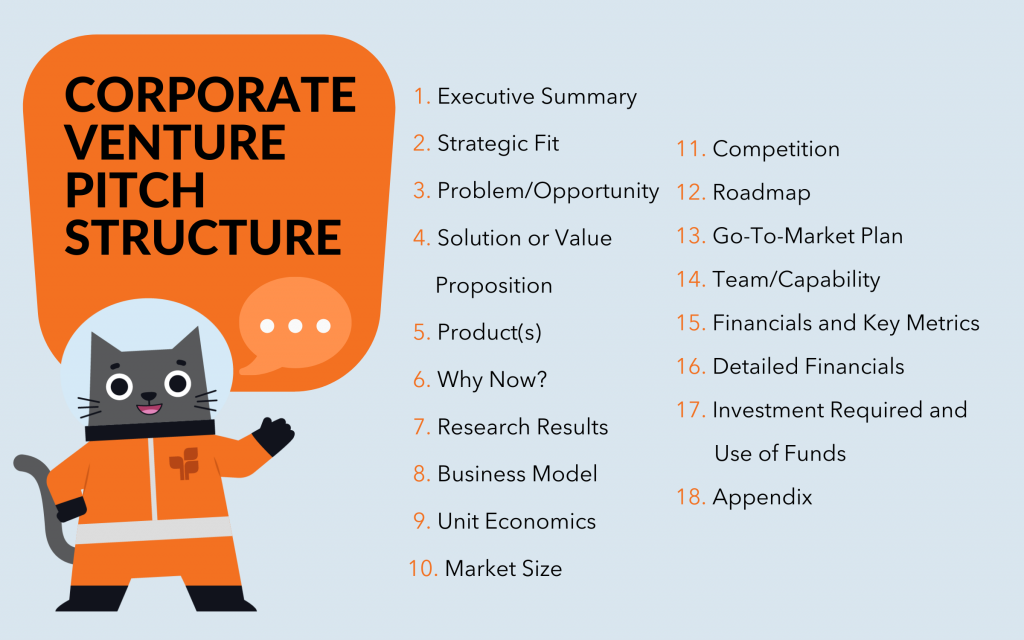
We’ve arrived at an almost standard template for the investment committee pitch of a corporate venture. The corporate venture template mostly follows the structure of a standard startup pitch but has a few key differences that are essential for ventures being built by an established business.
The standard startup pitch follows a common set of points, usually with a slide dedicated to each and an appendix. The sections and the order are almost an industry standard.
Sticking to this format makes it easy for investors and others to quickly understand what you’re doing. You can stray from this structure but doing so is a bit of a risk, where the risk is of people not understanding your venture so they don’t invest.
I’ve tried to play around with the order when pitching to investors and it didn’t work out. I’ve also been on the other side, trying to assess making investments in startups that strayed from the standard format. You end up with more uncertainty, so you end up politely passing.
Corporates are no different. Having a common format lets people quickly assess and understand the venture in the context of the business. It would be good to reuse the common structure startups usually use but a corporate version has some key differences, additional considerations as well as a need for greater rigour.
In this article we will look at:
- The common elements of a startup and corporate pitch
- The corporate specific considerations
- The sections of the corporate venture template
Common Elements
The common elements between a startup pitch and a corporate venture pitch template are:
- Problem/opportunity
- Solution or value proposition
- Product(s)
- Why now?
- Business model
- Market size
- Go-to-market plan
- Competition
- Team – although the contents usually differ significantly
- Financials and key metrics
- Investment required and use of funds
How the Corporate Venture Pitch Differs
The pitch for a corporate venture usually differs from the standard startup pitch. Here are the different sections you will most commonly see:
1. Executive Summary
A corporate venture pitch deck needs a single slide, usually with small font and diagrams, that provides a brief overview of the key points from the entire pitch. The summary is usually factual, to-the-point and comprehensive in a way that gives stakeholders the ability to quickly understand and assess the venture but somewhat removes your ability to take your stakeholders on a journey. The nature of the summary also means it can lead to misunderstandings.
2. Strategic Fit
You need to articulate how the corporate venture fits the corporate strategy. This is one of the most crucial slides because the better your venture fits the corporate strategy, the more likely you are to get the green light to proceed even if some of the other aspects of the venture aren’t as strong.
3. Team or Capability
Big companies tend to focus less on the team – the founders, key executives, advisors – in the startup sense of the word and focus more on the ‘capability’ or ‘resources’ – the people – required. This is where you show headcount, the roles required and when you require them.
4. Research Results
You will need to detail and share the results of any research or work you have already conducted, particularly around customer needs and the market. This could be desktop research, landing page experiments, customer interviews, surveys or prototypes.
5. Roadmap
Sometimes investment committees will want to see a clearly defined roadmap for the product(s) that the venture will be building, particularly if the corporate has product build teams.
6. Detailed Financials
You will most likely need to include more comprehensive detailed financials than you might for a startup pitch deck. In some instances, depending on the magnitude of the investment, you may also need to include metrics from corporate finance to allow executives to compare the returns of this investment against other investments they could make.
7. Investment Required
In startup land, the collective wisdom has arrived at presenting a single number (e.g. “we need $2m”) however companies and executives usually prefer to see options rather than a single number (e.g. “$2m option, $5m option, $20m option with recommendation for $5m.”). Also, executives will want to see the future funding you will require beyond this funding request. On this slide, you may also want to specify where the budget will come from within the business.
In addition to the common elements, here are some of the other differences you will see:
1. Content Per Page
While startup pitches will focus more on storytelling with less information per slide a corporate venture pitch will likely have significantly more text per slide and more information.
2. Branding
Use of the corporate branding rather than the new venture because this gives your stakeholders the sense that it has been through the right internal processes.
Corporate Venture Pitch Structure
So now, for a corporate venture pitch, the structure usually looks something like this:
- Executive summary
- Strategic fit
- Problem/opportunity
- Solution or value proposition
- Product(s)
- Why now?
- Research results
- Business model
- Unit economics
- Market size
- Competition
- Roadmap
- Go-to-market plan
- Team/capability
- Financials and key metrics
- Detailed financials
- Investment required and use of funds
- Appendix
Further Reading
Startup pitch decks:
- Guy Kawasaki’s book Art of the Start popularised the 10 slides for a startup pitch. You can also see a template on his website.
- Sequoia’s pitch deck structure
- YC’s seed stage deck
More on Corporate Ventures:
- Is This New Corporate Venture Big Enough?
- Rethinking The Role Of Coporate Venture
- New Venture Playbook
I’m on the lookout to build and invest in tech joint ventures with market leaders. Find more about joint venturing with Terem and let’s create something together.

Scott Middleton
CEO & Founder
Scott has been involved in the launch and growth of 61+ products and has published over 120 articles and videos that have been viewed over 120,000 times. Terem’s product development and strategy arm, builds and takes clients tech products to market, while the joint venture arm focuses on building tech spinouts in partnership with market leaders.
Twitter: @scottmiddleton
LinkedIn: linkedin.com/in/scottmiddleton